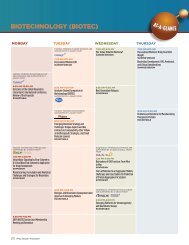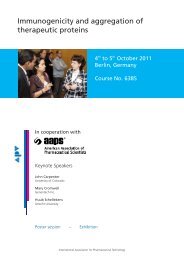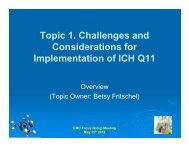Establishing a Relationship between Disintegration and Dissolution
Establishing a Relationship between Disintegration and Dissolution
Establishing a Relationship between Disintegration and Dissolution
You also want an ePaper? Increase the reach of your titles
YUMPU automatically turns print PDFs into web optimized ePapers that Google loves.
<strong>Establishing</strong> a <strong>Relationship</strong> <strong>between</strong><br />
<strong>Disintegration</strong> <strong>and</strong> <strong>Dissolution</strong><br />
AAPS: DISSOLUTION WORKSHOP<br />
Rhodes University, Grahamstown<br />
December 09-10, 2009<br />
Dr. Johannes Krämer<br />
<strong>Relationship</strong> <strong>between</strong><br />
<strong>Disintegration</strong> <strong>and</strong> <strong>Dissolution</strong>....<br />
Content<br />
• The scientific rationale<br />
• The chance to waive dissolution testing: ICH Q6A<br />
• Methods of establishing a relationship<br />
• Results for specimen under investigation<br />
• Extension to complete product line<br />
• Setting specifications for disintegration testing<br />
© PHAST GmbH, www.phast.de 2<br />
12/18/2009<br />
1
Risk evaluation m<strong>and</strong>atory<br />
prior to start<br />
To include<br />
• Vital medical indication (e.g. antiepileptic drug)<br />
• Narrow therapeutic index (e.g. Annex to SUPAC IR)<br />
• Extended BCS<br />
– stability in the GI tract<br />
– enterohepatic cycle<br />
– absorption window…<br />
• Dosage form evaluation<br />
– excipients<br />
• ….<br />
© PHAST GmbH, www.phast.de 3<br />
Goals of <strong>Dissolution</strong> Testing<br />
• prediction p of changes g of bioavailability, y, the<br />
surrogate-parameter of therapeutic efficacy<br />
• evaluation of robustness as a parameter of drug<br />
product- related safety<br />
critical manufacturing variables<br />
• in QC (quality control) to prove uniformity of<br />
product quality within the technological range<br />
of manufacturing processes<br />
© PHAST GmbH, www.phast.de 4<br />
12/18/2009<br />
2
Prediction of Bioperformance<br />
based on BCS<br />
© PHAST GmbH, www.phast.de 5<br />
Biopharmaceutics<br />
Classification Scheme (BCS)<br />
• solubility of drug<br />
substance under<br />
physiological pHconditions<br />
• permeability of drug<br />
substance in an<br />
isolated segment of<br />
human jejunum at pH<br />
6.5<br />
© PHAST GmbH, www.phast.de 6<br />
12/18/2009<br />
3
BCS - a base to establish specifications<br />
for in vitro dissolution testing<br />
definition of solubility<br />
"high solubility" if dose/solubility volume < 250 ml<br />
highest unit dose of drug is dissolved in buffer solutions at<br />
within physiological range (pH 1.2 – 8.0) at 37°C. The<br />
quotient of highest unit dose <strong>and</strong> lowest concentration<br />
obtained in buffer solutions is determined<br />
e.g.: drug substance x has it’s lowest solubility at pH 1.2 with<br />
1.5 mg/mL.<br />
Tablets are available in dosage strengths 200 <strong>and</strong> 300 mg.<br />
300 mg / 1.5 mg/mL = 200 mL -> high solubility drug<br />
© PHAST GmbH, www.phast.de 7<br />
Biopharmaceutics Drug<br />
Classification Scheme (BCS) cont’d<br />
solubilityy permeability<br />
p y<br />
case 1 high high<br />
case 2 low high<br />
case 3 high low<br />
case 4 low low<br />
© PHAST GmbH, www.phast.de 8<br />
12/18/2009<br />
4
<strong>Dissolution</strong> Spec’s …<br />
IR Dosage Forms according to US FDA:<br />
An IR product is considered rapidly dissolving if<br />
≥ 85% of the labeled amount dissolves<br />
within 30 min<br />
Apparatus @ 100/150 or Apparatus @ 50/75 rpm<br />
in 900 mL in each of the following media:<br />
1) 0.1N HCl or SGF without enzymes <strong>and</strong><br />
2) buffer pH 4.5 <strong>and</strong><br />
3) buffer pH 6.8 or SIF without enzymes<br />
© PHAST GmbH, www.phast.de 9<br />
Using ICH Q 6A Guideline …<br />
Decision Tree # 7:<br />
Setting Acceptance Criteria for Drug Product <strong>Dissolution</strong><br />
1. What type of drug release acceptance criteria are<br />
appropriate?<br />
Is the dosage<br />
form designed to produce<br />
modified release?<br />
NO<br />
General single-point dissolution<br />
acceptance criteria with a<br />
lower limit are acceptable<br />
Is drug solubility<br />
at 37 ± 0.5°C high throughout<br />
the physiological pH range?<br />
(Dose/solubility ≤ 250 mL<br />
( (pH H 11.2 2 - 68)) 6.8))<br />
YES<br />
© PHAST GmbH, www.phast.de 10<br />
12/18/2009<br />
5
Using ICH Guideline …<br />
IIs dosage d form f<br />
dissolving rapidly?<br />
(<strong>Dissolution</strong> >80%/15min<br />
at pH 1.2, 4.0, <strong>and</strong> 6.8)<br />
NO<br />
General single-point dissolution<br />
acceptance criteria with a<br />
lower limit are acceptable<br />
YES General single-point dissolution<br />
acceptance p criteria with a<br />
lower limit are acceptable<br />
Has a relationship been<br />
determined <strong>between</strong><br />
disintegration <strong>and</strong> dissolution?<br />
General disintegration<br />
acceptance criteria with an<br />
upper time limit are acceptable<br />
© PHAST GmbH, www.phast.de 11<br />
<strong>Relationship</strong> <strong>between</strong> disintegration<br />
<strong>and</strong> dissolution<br />
per se not a correlation:<br />
• disintegration in QC is defined as time of completeness of a<br />
kinetic process<br />
• dissolution in QC is amount of completeness at a specified<br />
time<br />
• no analogous parameters for a correlation available<br />
Has a relationship been<br />
determined <strong>between</strong><br />
disintegration <strong>and</strong> dissolution?<br />
© PHAST GmbH, www.phast.de 12<br />
12/18/2009<br />
6
<strong>Relationship</strong> <strong>between</strong><br />
disintegration <strong>and</strong> dissolution<br />
disintegration an integral part of <strong>and</strong> / or<br />
prerequisite for dissolution for IR dosage forms<br />
dissolution a composite process<br />
• dissolving from the surface of tablet<br />
• disintegration a surface enlarging process<br />
• deaggregation <strong>and</strong> separation of excipients <strong>and</strong> API<br />
• dissolution of API particles<br />
© PHAST GmbH, www.phast.de 13<br />
<strong>Dissolution</strong> - a composite<br />
process<br />
#D # Drug molecules l l<br />
<br />
• • ••<br />
release<br />
<br />
<br />
<br />
<br />
••<br />
•<br />
• •<br />
• • • •<br />
• • • •<br />
⌫⌫ ⌫<br />
⌫⌫<br />
⌫<br />
USP: fundamentals of dissolution, 2009<br />
© PHAST GmbH, www.phast.de 14<br />
12/18/2009<br />
7
Sigmoid <strong>Dissolution</strong> Curve of<br />
Solid Dosage Forms<br />
100%<br />
% Drug Dissolved<br />
0%<br />
Mechanical Lag<br />
+<br />
WWetting tti<br />
Deaggregation<br />
<strong>Disintegration</strong><br />
Occlusion,<br />
instability…<br />
Time<br />
USP: fundamentals of dissolution, 2009<br />
© PHAST GmbH, www.phast.de 15<br />
<strong>Relationship</strong> <strong>between</strong><br />
disintegration <strong>and</strong> dissolution<br />
A Case Report for a BCS Class I Drug<br />
© PHAST GmbH, www.phast.de 16<br />
12/18/2009<br />
8
<strong>Relationship</strong> <strong>between</strong><br />
disintegration <strong>and</strong> dissolution<br />
study protocol:<br />
• prove that disintegration is the prerequisite for dissolution<br />
• defining comparable parameters<br />
– i.e. amount dissolved at the time of complete disintegration in<br />
the dissolution apparatus<br />
• comparing analogous parameters for<br />
– freshly manufactured batches<br />
– ffor samples l after f accelerated l d stability bili treatment<br />
– extension to historical data of batches successfully released<br />
• proof of assumption: amount dissolved at the time of<br />
complete disintegration in the disintegration apparatus is<br />
comparable to process analyzed for the dissolution<br />
apparatus<br />
© PHAST GmbH, www.phast.de 17<br />
M containing IR products<br />
under investigation<br />
tablet shape<br />
special*1 special* special* special*1 special*1<br />
*1 *2<br />
C-excipient/mg p g<br />
per tablet<br />
1.0 5.0<br />
*2<br />
tablet mass / mg 174 174 174 174 174 174<br />
*1 investigated with dissolution method 1 to 3<br />
*2 investigated with dissolution method 1 only<br />
= round tablet<br />
special = anisodiametric<br />
= round tablet with cross-st<strong>and</strong>ing braking notches<br />
© PHAST GmbH, www.phast.de 18<br />
12/18/2009<br />
9
Methods: <strong>Dissolution</strong> n=12<br />
apparatus <br />
medium pH 1.2 pH 4.5 pH 6.8<br />
medium degassed degassed degassed<br />
volume 500/900 mL 500/900 mL 500/900 mL<br />
agitation 100 rpm 100 rpm 100 rpm<br />
temperature 37°C 37°C 37°C<br />
sampling<br />
at 5, 10, 15, 20, 25, 30, <strong>and</strong> 45 min<br />
at the time of complete disintegration<br />
© PHAST GmbH, www.phast.de 19<br />
Methods: <strong>Disintegration</strong><br />
according to USP<br />
• with n=12<br />
• use of water<br />
sampling<br />
• at the time of complete disintegration<br />
• at a zone validated prior to testing<br />
• pooled sampling for n=6<br />
© PHAST GmbH, www.phast.de 20<br />
12/18/2009<br />
10
Methods: chemical analysis,<br />
data evaluation<br />
chemical analysis<br />
• derivative spectroscopy<br />
data evaluation<br />
• disintegration time<br />
– with regard to dossier / compendial requirements<br />
– using g Statistical Moment Theoryy<br />
• dissolution profiles<br />
– with regard to ICH spec’s<br />
– using the Statistical Moment Theory<br />
© PHAST GmbH, www.phast.de 21<br />
Statistical Moment Theory:<br />
Mean Times<br />
MDT vitro = tM(t)dt / M(t)dt<br />
0 0<br />
⎡ ⎤<br />
⎢ ⎥<br />
⎣ ⎦<br />
⎡<br />
∞ ∞<br />
⎤<br />
∫ ⎢∫<br />
⎥<br />
⎣ ⎦<br />
M = drug released<br />
MDT MDTvitro = MMean Di <strong>Dissolution</strong> l ti Ti Time iin vitro<br />
it<br />
© PHAST GmbH, www.phast.de 22<br />
12/18/2009<br />
11
Additivity of Mean Times<br />
Mean Times: data reduction taking g into account curtosy y <strong>and</strong> skewness of<br />
distributions.<br />
•The processes are overlapping <strong>and</strong> therefore, distributions do also overlap.<br />
• According to the theory of statistical moments the statistical moments are<br />
adding up<br />
MDT pH 1.2 = MDgT_Dissol1.2 + MDislnT 1.2<br />
MDT pH 1.2 the mean dissolution time in dissolution apparatus @ pH 1.2<br />
MDgT_Dissol1.2 the mean disintegration time in dissolution apparatus @<br />
pH 1.2<br />
MDislnT 1.2 the mean terminal dissolution time after disintegration in the<br />
dissolution appartus @ pH 1.2<br />
© PHAST GmbH, www.phast.de 23<br />
Results: Solubility<br />
pH 1.2 125 103.1<br />
pH 1.2 250 97.2<br />
pH 4.0 125 106.3<br />
pH 4.0 250 97.0<br />
pH 6.8 125 100.5<br />
pH 6.8 250 104.3<br />
highest dose is soluble in NMT 250 mL<br />
© PHAST GmbH, www.phast.de 24<br />
12/18/2009<br />
12
<strong>Establishing</strong> a relationship:<br />
Results BCS<br />
Solubility:<br />
• data prove good solubility<br />
Permeability:<br />
• data prove good permeability<br />
therefore, substance M is a BCS class I compound<br />
© PHAST GmbH, www.phast.de 25<br />
Results: <strong>Dissolution</strong> kinetics<br />
product name<br />
/ geometry<br />
pH 5 10 15 20 25 30 45<br />
M / 1.2 102.8 103.1 103.3 102.6 102.4 102.9 102.6<br />
4.5 86.5 90.9 94.3 96.7 96.5 96.8 99.4<br />
6.8 92.3 96.7 98.3 100.2 101.1 100.4 101.9<br />
1.2 102.8 103.1 103.3 102.6 102.4 102.9 102.6<br />
4.5 86.5 90.9 94.3 96.7 96.5 96.8 99.4<br />
dissolution >> 80% in 30 min <strong>and</strong> in 15 min<br />
© PHAST GmbH, www.phast.de 26<br />
12/18/2009<br />
13
Results: amount dissolved at<br />
time of disintegration at pH 1.2<br />
tablets<br />
in the<br />
dissolution<br />
apparatus<br />
at pH 1.2<br />
product d t name/ /<br />
geometry<br />
index<br />
disintegration<br />
time dissolution<br />
apparatus [s]<br />
amount<br />
dissolved [%]<br />
M 1.25 / 1 60.0 64.8<br />
2 65.0 89.2<br />
3 60.0 87.5<br />
4 60.0 78.9<br />
5 60.0 91.7<br />
6 60.0 79.0<br />
7 55.0 86.2<br />
© PHAST GmbH, www.phast.de 27<br />
Amount dissolved app.<br />
pH 1.2, 4.5, <strong>and</strong> 6.8 vs. disintegration<br />
time in water (mean, n=12)<br />
dissolved API [%]<br />
120<br />
100<br />
80<br />
60<br />
40<br />
20<br />
8 55.0 87.8<br />
9 55.0 91.5<br />
10 60.0 98.3<br />
11 65.0 85.7<br />
12 65.0 89.6<br />
<strong>Dissolution</strong> [%] / <strong>Disintegration</strong> time [s] (dissolution apparatus)<br />
0<br />
0 50 100 150 200 250<br />
<strong>Disintegration</strong> time [s]<br />
pH 6.8<br />
pH 4.5<br />
pH 1.2<br />
© PHAST GmbH, www.phast.de 28<br />
12/18/2009<br />
14
Findings<br />
• MDgT MDgT_Disint Disint shows higher variability than MDT @ pH 11.2 2 -<br />
6.8.<br />
• This identifies the disintegration method as more variable.<br />
• From the MDgT_Dissol at pH 4.5 <strong>and</strong> 6.8 it can be<br />
concluded that the disintegration process is the most<br />
variable sub sub-process process, whereas the MDislnT at pH 4.5 4 5 <strong>and</strong><br />
6.8 are much less variable.<br />
© PHAST GmbH, www.phast.de 29<br />
Summary<br />
Conclusions:<br />
• <strong>Disintegration</strong> is the prerequisite for dissolution<br />
• At the time of complete disintegration a rather constant<br />
amount of drug is being dissolved<br />
• This is valid for the dissolution apparatus <strong>and</strong> the<br />
disintegration apparatus<br />
• The sub-processes are overlapping, with the help of<br />
statistical moment theory the sub-processes can be clearly<br />
ddescribed ib d<br />
• <strong>Disintegration</strong> is the most variable sub-process<br />
The relationship of disintegration <strong>and</strong> dissolution is<br />
a cause <strong>and</strong> effect relation<br />
© PHAST GmbH, www.phast.de 30<br />
12/18/2009<br />
15
ICH Q6A decision tree #7<br />
criteria are met<br />
No modified release dosage form<br />
Solubility is high throughout the physiological range pH 1.2 to 6.8<br />
<strong>Dissolution</strong> is rapid <strong>and</strong> complete. Under all experimental<br />
conditions > 80 % in 15 min<br />
No analogous data result form dissolution <strong>and</strong> disintegration<br />
No linear stochastical relationship is feasible<br />
A relationship of disintegration as the rate limiting step for<br />
dissolution was described<br />
The findings for the dissolution tester were confirmed for the<br />
disintegration tester (data not shown)<br />
<strong>Disintegration</strong> was found to be the more variable process<br />
The data generated for actual production lots represent the<br />
properties of the drug product (historical data)<br />
As a consequence:<br />
The dissolution test may be waived for batch release testing for all<br />
formulations included in the study<br />
© PHAST GmbH, www.phast.de 31<br />
Finally: Setting Specifications<br />
<strong>Dissolution</strong> testing as a biopharmaceutically<br />
relevant test procedure may be waived!<br />
• <strong>Disintegration</strong> is prerequisite for dissolution recommended<br />
for batch release testing<br />
• Comparison of the disintegration results together with the<br />
dissolution results for the disintegration apparatus allows<br />
tightening of spec’s to 5 min (Ph,Eur. / USP: 15 min)<br />
For all immediate release dosage strengths of that<br />
M containing product, the spec’s for<br />
disintegration time were set: NMT 5 min<br />
© PHAST GmbH, www.phast.de 32<br />
12/18/2009<br />
16
Thank you<br />
www www.artofdissolution.com<br />
artofdissolution com<br />
© PHAST GmbH, www.phast.de 33<br />
12/18/2009<br />
17






